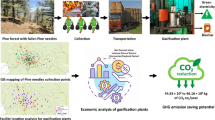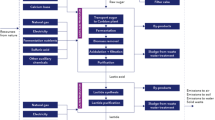Abstract
The biogas-linked agro-ecosystem plays a critical role in the sustainable development of rural China. In this study, emergy analysis was performed to assess the sustainability of a biogas-linked ecological orchard system in the Loess Plateau area. To analyze the system more comprehensively, the overall orchard system was divided into three subsystems, including the biogas subsystem, the greenhouse subsystem, and the orchard subsystem. Other than the conventional indicators, two novel indicators suitable for orchard ecosystems, the system production dominance and index of system stability, were developed to evaluate the overall performance of the system and subsystems. The results showed significant variations in multiple performances of the subsystems regarding resource utilization, renewability, and production capacity. The circulation of emergy flows among different subsystems revealed a promising renewable capacity and self-organizing ability for the overall system, which further suggests the advantage of this mode in terms of sustainability. As revealed by the emergy indicators, the biogas-linked ecological orchard as an ecological practice is feasible for modern agriculture involving intensive fruit production and breeding, as it can guarantee highly efficient resource recycling and energy conservation without destroying the local environment.
Graphical abstract





Similar content being viewed by others
References
Baral NR, Wituszynski DM, Martin JF, Shah A, Lund H, Kaiser MJ (2016) Sustainability assessment of cellulosic biorefinery stillage utilization methods using emergy analysis. Energy 109:13–28
Cabell JF, Oelofse M (2012) An indicator framework for assessing agroecosystem resilience. Ecol Soc 17:66–74
Campbell DE, Garmestani AS (2012) An energy systems view of sustainability: emergy evaluation of the San Luis Basin, Colorado. J Environ Manage 95:72–97
Cavalett O, Queiroz JD, Ortega E (2006) Emergy assessment of integrated production systems of grains, pig and fish in small farms in the South Brazil. Ecol Model 193:205–224
Chasnyk O, Sołowski G, Shkarupa O (2015) Historical, technical and economic aspects of biogas development: case of Poland and Ukraine. Renew Sustain Energy Rev 52:227–239
Chen S, Chen B (2012) Sustainability and future alternatives of biogas-linked agrosystem (BLAS) in China: an emergy synthesis. Renew Sustain Energy Rev 16:3948–3959
Chen B, Chen SQ (2013) Life cycle assessment of coupling household biogas production to agricultural industry: a case study of biogas-linked persimmon cultivation and processing system. Energy Policy 62:707–716
Cheng H, Chen CD, Wu SJ, Mirza ZA, Liu ZM (2017) Emergy evaluation of cropping, poultry rearing, and fish raising systems in the drawdown zone of Three Gorges Reservoir of China. J Clean Prod 144:559–571
China Statistical Yearbook (2014) Shaanxi development yearbook 2014. https://www.chinayearbooks.com/categories/local/shaanxi. Accessed 14 June 2015
Duan N, Lin C, Liu XD, Wang Y, Zhang XJ, Hou Y (2011) Study on the effect of biogas project on the development of lowcarbon circular economy—a case study of Beilangzhong eco-village. Procedia Environ Sci 5:160–166
Duan N, Lin C, Liu XD, Wen S, Zhang X (2015) Energy analysis of biogas-linked eco-village circulating system. Trans Chin Soc Agric Eng 31(Suppl. 1):261–268
Fang W, An HZ, Li HJ, Gao XY, Sun XQ, Zhong WQ (2017) Accessing on the sustainability of urban ecological-economic systems by means of a coupled emergy and system dynamics model: a case study of Beijing. Energy Policy 100:326–337
Gao WS, Chen YQ, Liang L (2007) Basic principles and technology supporting for circular agriculture development. Reas Agric Mod 28:731–734
Han Y, Long P, Chen YQ, Sui P, Gu SG (2013) Research progress of evaluation system for China circular agriculture development. Chin J Eco-Agric 21:1039–1048
Hijazi O, Munro S, Zerhusen B, Effenberger M (2016) Review of life cycle assessment for biogas production in Europe. Renew Sustain Energy Rev 54:1291–1300
Hussain M, Malik RN, Taylor A (2017) Carbon footprint as an environmental sustainability indicator for the particleboard produced in Pakistan. Environ Res 155:385–393
Jiang MM, Chen B, Zhou JB, Tao FR, Li Z, Yang ZF, Chen GQ (2007) Energy account for biomass resource exploitation by agriculture in China. Energy Policy 35:4704–4719
Lan SF, Qin P, Lu HF (2002) Emergy analysis of eco-economic system. Chemical Industry Press, Beijing
Li XP, Sun DL (2000) Systemical analysis on production dominance and stability of comprehensive planting pattern of winter wheat–spring corn–summer corn in Huabei Plain. Syst Sci Compr Stud Agric 4:256–259
Li HK, Wan YZ, Wang M, Han MY, Huo XX (2015) History, status and prospects of the apple industry in China. J Am Pomol Soc 69:174–185
Li CH, Liu Z, Wang H, Yu NW, Zhang XM, Sun QZ (2016) Status analysis and key technology of high efficiency of apple industry in China. North Hortic 3:174–177
Liu JJ (2013) Research on indicator system and comprehensive evaluating method of eco-orchard benefit. Northwest A&F University, Yangling
Liu JR, Berge HFMT, Zhang M, Wu J, Guo C, Liu WD (2002) Nitrogen cycling in an ecological farming system of milk vetch culture–pig-raising–biogas fermentation–rice culture. Plant Prod Sci 5:65–70
Liu JJ, Qiu L, Yuan JW (2007) Benefit evaluation of economy on loess altiplano biogas eco-orchard model. J Agric Mech Res 4:49–52
Liu Y, Kuang YQ, Huang NS, Wu ZF, Xu LZ (2008) Popularizing household-scale biogas digesters for rural sustainable energy development and greenhouse gas mitigation. Renew Energy 33:2027–2035
Liu GY, Hao Y, Dong L, Yang ZF, Zhang Y, Ulgiati S (2017) An emergy–LCA analysis of municipal solid waste management. Resour Conserv Recycl 120:131–143
Odum HT (1988) Self-organization, transformity, and information. Science 242:1132–1139
Odum HT (1996) Environmental accounting—emergy and environmental decision making. Wiley, New York
Ohnishi S, Dong H, Geng Y, Fujii M, Fujita T (2017) A comprehensive evaluation on industrial & urban symbiosis by combining MFA, carbon footprint and emergy methods—case of Kawasaki, Japan. Ecol Indic 73:513–524
Peter W (2010) Biogas production: current state and perspectives. Appl Microbiol Biotechnol 85:849–860
Qi X, Zhang S, Wang Y, Wang R (2005) Advantages of the integrated Pig–Biogas–Vegetable greenhouse system in North China. Ecol Eng 24:175–183
Qi J, Chen B, Dai J, Zhang JR, Chen SQ, Yang J (2012) Exergy-based life cycle accounting of household biogas system: a case study of Gongcheng, Guangxi. Acta Ecol Sin 32:4246–4253
Qiu L (2001) Optimum design for model of “5 complete sets” eco-orchard engineering. Renew Energy Resour 97:14–16
Quezada CA, Fonseca MB, Romero H (2016) The circular agriculture applied in neighboring countries: the case of biogas on the border between Ecuador and Perú. New Biotechnol 33:S66–S67
Rodríguez-Ortega T, Bernués A, Olaizola AM, Brown MT (2017) Does intensification result in higher efficiency and sustainability? An emergy analysis of Mediterranean sheep–crop farming systems. J Clean Prod 144:171–179
Saladini F, Vuai SA, Langat BK, Gustavsson M, Bayitse R, Gidamis AB (2015) Sustainability assessment of selected biowastes as feedstocks for biofuel and biomaterial production by emergy evaluation in five African countries. Biomass Bioenergy 85:100–108
Sun L, Tian GC, Wu FQ (2015) Emergy evaluation of a Pig-Methane-Grain circular agricultural mode in Guanzhong Plain. Agric Res Arid Areas 33:246–252
Tsukamoto T, Jaber N, Wakabayashi S, Noguchi N (2012) Characteristics of exhaust gas emission during dual-fuel operation with biogas. J Jpn Soc Agric Mach 70:113–119
Ulgiati S, Brown MT (1998) Monitoring patterns of sustainability in natural and man-made ecosystems. Ecol Model 108:23–36
Wang HH, Wu FQ, Li RB (2008) Emergy analysis of peasant household crop-fruit ecosystem in middle and south Loess Plateau. Agric Res Arid Areas 26:197–204
Wang SL, Yang JS, Wang RL, Li RQ, Wang ST, Liu KF (2014) Effects of biogas residue on soil improvement in peach orchard. Appl Mech Mater 675–677:738–741
Wang XL, Dadouma A, Chen Y, Sui P, Gao WS, Jia L (2015) Sustainability evaluation of the large-scale pig farming system in north china: an emergy analysis based on life cycle assessment. J Clean Prod 102:144–164
Webler G, Roberti DR, Cuadra SV, Moreira VS, Costa MH (2012) Evaluation of a dynamic agroecosystem model (Agro-IBIS) for soybean in Southern Brazil. Earth Interact 16:1–15
Wei XM, Chen B, Qu YH, Lin C, Chen GQ (2009) Emergy analysis for ‘Four in One’ peach production system in Beijing. Commun Nonlinear Sci Numer Simul 14:946–958
Williamson TR, Tilley DR, Campbell E (2015) Emergy analysis to evaluate the sustainability of two oyster aquaculture systems in the Chesapeake Bay. Ecol Eng 85:103–120
Wu XF, Wu XD, Li JS, Xia XH, Mi T, Yang Q, Chen GQ, Chen B, Hayat T, Alsaedi A (2014) Ecological accounting for an integrated “pig–biogas–fish” system based on emergetic indicators. Ecol Indic 47:189–197
Wu XH, Wu FQ, Tong XG, Jia Wu, Sun L, Peng XY (2015) Emergy and greenhouse gas assessment of a sustainable, integrated agricultural model (SIAM) for plant, animal and biogas production: analysis of the ecological recycle of wastes. Resour Conserv Recycl 96:40–50
Yang J, Chen B (2014) Emergy analysis of a biogas-linked agricultural system in rural China—a case study in Gongcheng Yao autonomous county. Appl Energy 118:173–182
Yang ZF, Jiang MM, Chen B, Zhou BJ, Chen GQ, Li SC (2010) Solar emergy evaluation for Chinese economy. Energy Policy 38:875–886
Yang J, Chen W, Chen B (2011) Impacts of biogas projects on agro-ecosystem in rural areas—a case study of Gongcheng. Front Earth Sci 5:317–322
Yang YL, Zhang PD, Li GQ (2012) Regional differentiation of biogas industrial development in China. Renew Sustain Energy Rev 16:6686–6693
Zhang BY, Chen B (2017) Sustainability accounting of a household biogas project based on emergy. Appl Energy 194:819–831
Zhou LL, Wang XW, Tian FF, Jiang RY, Chen LC (2013) Study on the ‘Pig–Biogas–Vegetable’ circulation agriculture model in Northern Jiangsu area. North Hortic 23:219–220
Acknowledgements
This work was supported by the National Natural Science Foundation of China (No. 51576167). The authors would gratefully thank Dr Kang Kang and Dr Guotao Sun for their help in drawing figures and conducting the data analysis.
Author information
Authors and Affiliations
Contributions
CGZ and LQ designed the study together; CGZ provided the figures and tables of the manuscript and wrote the manuscript. All authors read and approved the manuscript.
Corresponding author
Ethics declarations
Conflicts of interest
The authors declare that they have no conflict of interest.
Rights and permissions
About this article
Cite this article
Zhang, C., Qiu, L. Comprehensive sustainability assessment of a biogas-linked agro-ecosystem: a case study in China. Clean Techn Environ Policy 20, 1847–1860 (2018). https://doi.org/10.1007/s10098-018-1580-9
Received:
Accepted:
Published:
Issue Date:
DOI: https://doi.org/10.1007/s10098-018-1580-9




